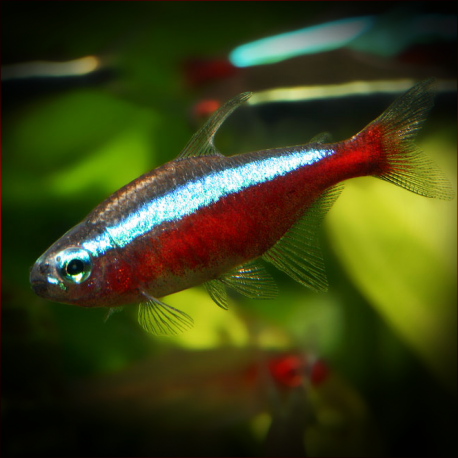More info
Datasheet
| Minimum Tank Size | 60 litres / 15.85 US gallons |
| Maximum Size | 3.5cm / 1.38inches |
| Temperature | 23°C / 73.40°F - 29°C / 84.20°F |
| Hardness | 1.01dgH / 18ppm - 12.05dgH / 215ppm |
| pH | 3.5-7.5 |
General Description
The Cardinal Tetra (Paracheirodon Axelrodi) is a popular and visually appealing species in the aquarium trade, known for its striking coloration and peaceful nature. It is part of the Characidae family and belongs to the classification order Characiformes. This species is commonly found in soft, acidic waters of forest streams and tributaries.
Aquarium Setup
To create an ideal environment for Cardinal Tetras, it is recommended to maintain a well-researched community aquarium. A mixed-sex group of at least 8-10 specimens is advised, along with similarly-sized characids, gasteropelecids, lebiasinids, smaller catfish species, and non-predatory cichlids. Including other schooling fish can provide a sense of security and result in a more natural-looking spectacle in the tank (see table for specific water conditions).
Behaviour
Cardinal Tetras are generally peaceful, making them suitable inhabitants for community aquariums. They tend to form schools and exhibit social behaviors within their group. In their natural habitat, these fish are known to form large schools during the dry season and adjust their behavior with the fluctuating water levels during seasonal changes.
Feeding and Diet
The Cardinal Tetra is likely an omnivorous species, feeding on small invertebrates, crustaceans, algae, fallen fruits, and more in the wild. In captivity, they can survive on a diet of dried foods, but a varied menu including live and frozen foods like bloodworm, mosquito larvae, Daphnia, and Moina is preferred for their optimal health.
Reproduction & Dimorphism
Breeding Cardinal Tetras requires setting up a dedicated tank with soft, acidic water and dim lighting. Spawning mops or fine-leaved plants can provide suitable surfaces for egg deposition. Sexually mature females are rounder and slightly larger than males. The eggs hatch in 24-36 hours, and the fry become free-swimming a few days later, requiring small live foods for nourishment.
Habitat and Distribution
In the wild, Cardinal Tetras inhabit forest streams and tributaries with slow-moving water. They are commonly found in the rio Negro basin in Brazil and parts of the Orinoco watershed in Venezuela. These habitats are characterized by acidic water, low carbonate hardness, and abundant organic matter. The species is known for its seasonal behavior in response to the Amazon's hydrological cycles.

